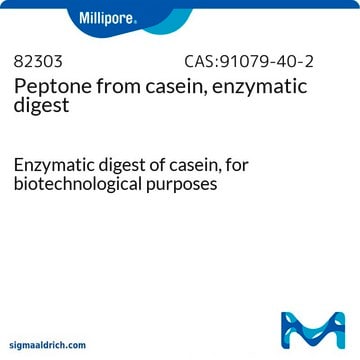T9410
Tryptone
Pancreatic digest of casein, Suitable for microbiology
Synonym(s):
Peptone from casein, Peptone from casein, casein tryptic digested
Sign Into View Organizational & Contract Pricing
All Photos(1)
About This Item
Recommended Products
biological source
bovine milk
Quality Level
form
powder
packaging
poly bottle of 1 kg
poly bottle of 250 g
nitrogen analysis
11.4-13.9% total
loss
≤11% loss on drying
pH
6.6-7.4
application(s)
microbiology
Looking for similar products? Visit Product Comparison Guide
Related Categories
General description
Tryptone is a general-purpose growth peptone produced by the digestion of casein with the protease trypsin and used as a nitrogen source in culture media formulated for isolating and cultivating fastidious and non-fastidious bacteria, fungi, and some protozoa. It is a refined hydrolysate with high solubility and is used as a microbiological nutrient in laboratory media and fermentations. It is a high-quality source of amino acids and peptides produced by the pancreatic digestion of casein.
Application
Tryptone is recommended for laboratory media and fermentation and has been used in antibiotics, toxins, and enzyme productions. It is also used as a nutrient in vaccine production where a high free amino acid content is required. Tryptone may also be used in STGG (skim milk, tryptone, glucose, glycerol) medium at -80°C, which is used to preserve Streptococcus pneumoniae, Haemophilus influenzae, and Moraxella catarrhalis isolates for at least 3 years.
Storage Class Code
11 - Combustible Solids
WGK
WGK 1
Flash Point(F)
Not applicable
Flash Point(C)
Not applicable
Personal Protective Equipment
dust mask type N95 (US), Eyeshields, Gloves
Choose from one of the most recent versions:
Certificates of Analysis (COA)
Lot/Batch Number
Don't see the Right Version?
If you require a particular version, you can look up a specific certificate by the Lot or Batch number.
Already Own This Product?
Find documentation for the products that you have recently purchased in the Document Library.
Customers Also Viewed
M B Hall
Journal of dairy science, 100(4), 2739-2750 (2017-02-22)
The availability of rumen-degradable protein (RDP) changes the use of carbohydrates by ruminal microbes. However, the effects of RDP on the simultaneous use of carbohydrate and formation of microbial products are not well described, although such information is needed to
M B Hall et al.
Journal of dairy science, 99(1), 245-257 (2015-11-26)
Fructans are an important nonfiber carbohydrate in cool season grasses. Their fermentation by ruminal microbes is not well described, though such information is needed to understand their nutritional value to ruminants. Our objective was to compare kinetics and product formation
Tarja Kaijalainen et al.
Journal of clinical microbiology, 42(1), 412-414 (2004-01-13)
In STGG (skim milk, tryptone, glucose, glycerol) medium at -80 degrees C, Streptococcus pneumoniae, Haemophilus influenzae, and Moraxella catarrhalis isolates survived for at least 3 years, and the same species have survived in nasopharyngeal swabs for at least 1.5 years.
S Gargallo et al.
Journal of dairy science, 103(7), 6209-6217 (2020-04-26)
Current feeding systems are based on the assumption that the AA profile of rumen undegraded protein is similar to that of the original feed. The objective of this experiment was to determine rumen bacterial degradation of individual essential AA in
Frederick K Balagaddé et al.
Science (New York, N.Y.), 309(5731), 137-140 (2005-07-05)
Using an active approach to preventing biofilm formation, we implemented a microfluidic bioreactor that enables long-term culture and monitoring of extremely small populations of bacteria with single-cell resolution. We used this device to observe the dynamics of Escherichia coli carrying
Our team of scientists has experience in all areas of research including Life Science, Material Science, Chemical Synthesis, Chromatography, Analytical and many others.
Contact Technical Service












